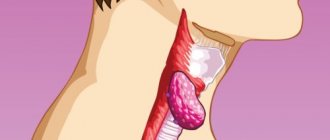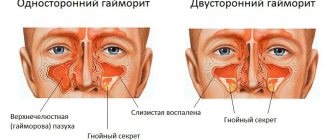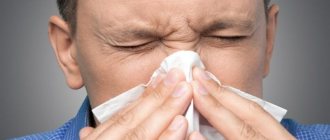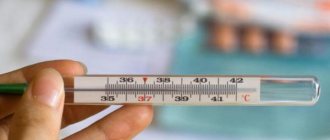Features of the disease
Lymphadenitis is a very common pathology, during which inflammation develops in the lymph nodes.
To understand the etiology of the disease, it is necessary to understand in more detail the physiological processes occurring in the human body. Lymph nodes represent a kind of barrier that restrains the spread of pathogenic microflora from the nearest focus of the inflammatory process throughout the system. However, there are cases when the lymph node itself becomes a source of infection in the event of suppuration. As a result, patients often require hospitalization and possibly surgery. It is quite difficult to obtain statistical data regarding the prevalence of pathology. The fact is that the disease often becomes a complication of other pathologies, for example, tonsillitis or purulent wounds, and its course is not very difficult. In such situations, therapy is aimed at the underlying disease, and lymphadenitis disappears without specific treatment. Therefore, patients with a very serious degree of pathology, which already requires serious medical and often surgical intervention, turn to a specialist.
Causes of pathology
As already indicated, in the vast majority of cases, inflammation occurs as a complication after an infectious process that has already been suffered.
This occurs for physiological reasons, when pathogens are carried by the lymph current to the nearest lymph node. If the body functions correctly and appropriate therapy is carried out, then the bacteria arrive there already in a weakened or killed state, or die directly in it. In this case, inflammation does not develop further. However, if the process is not stopped and the pathogen is very active, then inflammation is already developing in the node itself. In such a situation, lymphadenitis is secondary. However, there are cases when the pathology is primary.
This can occur as a result of trauma to the lymph node area, during which the strain penetrates through the site of injury. It should be noted that such pathologies are very rare and occur against the background of reduced immune defense. The cause of nonspecific lymphadenitis in most cases is staphylococcal and streptococcal infections .
The nodes enter through the flow of blood or lymph. The most common foci of primary inflammation include: carbuncles, boils, infected wounds, thrombophlebitis, osteomyelitis and others. A specific type of pathology is caused by a special type of pathogen that provokes the appearance of specific diseases, for example, gonorrhea, syphilis, tuberculosis, plague, anthrax and others. In such situations, the localization of the inflammatory process occurs in the node closest to the site of infection. So, in case of a sexually transmitted disease, the inguinal nodes are the first to react.
Symptoms of inflammation of the lymph nodes
The inflammatory process in the lymph nodes in the neck manifests itself:
- changes in body temperature;
- discomfort in the area of the organ involved in the abnormal process;
- general weakness and manifestations of intoxication of the body;
- changes in the shape and size of lymph nodes;
- swelling of nearby tissues.
Symptoms of the anomaly can appear either individually or simultaneously, depending on the cause of the pathology and the severity of the inflammatory process.
In the chronic course of the disease, the cells of the lymph node are replaced by connective tissue, the outflow of lymph is disrupted, as a result of which severe tissue swelling occurs in the area of the affected organ. The growing connective tissue leads to the formation of elephantiasis.
With sexually transmitted infections, there is an alternating increase in several or all lymph nodes in the area in question. Tuberculosis provokes inflammation of several lymph nodes on one side.
Clinical picture
Depending on the type of bacterial pathology, clinical symptoms will vary. However, there are general manifestations of lymphadenitis that are characteristic of any type of inflammatory process.
General symptoms:
- the lymph node increases in size;
- redness of the skin appears over the lymph node;
- upon palpation, the area reveals quite severe pain;
- local temperature rises at the site of inflammation.
In many ways, clinical symptoms depend on the location of the inflamed node. Thus, damage to the abdominal lymph nodes can provoke significant tension in the abdominal muscles, up to the symptoms of peritonitis.
Cervical lymphadenitis causes difficulty swallowing, and inguinal lymphadenitis causes problems with urination. Inflammation of the lymph node in the sternum area is very similar in symptoms to heart pathologies, because it can cause quite severe pain.
Common nonspecific symptoms include:
- increase in body temperature to febrile levels (up to 38 degrees Celsius);
- deterioration due to intoxication (fatigue, dizziness);
- the appearance of dyspeptic disorders.
To determine the type of causative agent of the inflammatory process, it is not enough to conduct only an examination; it is necessary to undergo clinical tests.
This is due to the fact that the lesion can be not only bacterial, but also viral in origin. For this purpose, a general blood test is prescribed. The presence of a bacterial process is indicated by an increase in the level of leukocytes and neutrophils, as well as an increase in the erythrocyte sedimentation rate. In theory, before prescribing antibacterial therapy, it is necessary to perform a puncture and verify the specific type of pathogen and its sensitivity to antibiotics. However, bacterial culture takes about a week and this time may not exist. Therefore, the analysis is usually carried out immediately before the start of therapy, during which broad-spectrum antibiotics are started.
Causes of the disease
Lymph nodes in the human body perform a vital function - they filter lymph from various pathologies and viruses. They can be called “cogs” of the body, without which this complex mechanism cannot function fully. Sometimes these “cogs” become inflamed, and then treatment of the lymph nodes in the neck is required.
The inflammatory process itself in the lymph nodes indicates that toxins and pathogens have entered the body. Naturally, this process requires the immediate intervention of a doctor, who will not only stop the course of the disease, but also prevent the occurrence of complications. A specialist may prescribe antibiotics for inflammation of the lymph nodes, as well as additional preventive measures.
Lymphatic glands constitute an entire system, which, in addition to a network of nodes, also includes vessels, ducts and other organs whose task is to cleanse the lymph. Despite the fact that one of the main functions of the lymph node is the production of white blood cells that fight infections in the body, the nodules themselves can also be affected by infections. If this happens, they increase in size, pain and inflammation appear.
Quite often, damage to the lymph nodes is very noticeable exactly where the main inflammation occurs. This problem can be caused by bacterial or skin infections, as well as very dangerous diseases such as “cat” fever or tuberculosis. And yet, the main cause of inflammation is hypothermia or excessive exposure to the sun, as well as acute infections.
Most often, the lymph nodes in the neck can become inflamed in young children, although some adults are also familiar with this problem.
A nonspecific form of the course of this disease is observed if advanced clinical conditions or some untreated diseases are present:
- advanced sore throat;
- trophic ulcers;
- erysipelas;
- thrombophlebitis;
- periodontitis or caries;
- purulent-inflammatory processes in the oral cavity;
- infections that have penetrated soft tissue (for example, during surgery).
Antibiotics for inflammation of the lymph nodes
To understand which antibiotics should be used for a particular pathology, it is necessary to pay attention to certain factors. There is clinical evidence that in most cases, nonspecific lymphadenitis is caused by streptococcal and staphylococcal microorganisms. That is why it is customary to prescribe antimicrobial agents that are most effective against them.
In addition, it is necessary to take into account the severity of the disease, the patient’s age and the presence of concomitant pathologies. Despite the fact that lymphadenitis has a very clear clinical picture, its features vary somewhat from patient to patient. Elderly people, young children and patients with chronic decompensated conditions are very prone to the formation of sepsis, which may well be fatal. Therefore, in such situations, a more powerful medication, or a combination of both, is often prescribed.
A characteristic feature of each type of antibiotic is the place where they accumulate. Due to the characteristics of the disease, it is preferable to use a product with a concentration in the human lymphatic system. For the best effect, it is also recommended to take into account the patient’s medical history and medication history. If a few months ago the patient already underwent antimicrobial therapy, then it is necessary to select a drug from a different group.
Modern tactics for treating pathology involve dividing drugs into first and second lines. Initially, safer drugs with a broad spectrum of action are prescribed. However, if they turn out to be ineffective or cause an allergic reaction, then you have to move on to second-line drugs.
For lymphadenitis use:
- penicillins;
- cephalosporins;
- macrolides;
- fluoroquinolones;
- lincosamides;
- aminoglycosides.
Penicillins
This class of antimicrobial agents was found earlier than others and has been widely used in medical practice for many decades. They have a very wide spectrum of bactericidal effects. However, due to long-term use, many pathogens have developed resistance to these medications.
Augmentin
Therefore, they began to produce protected penicillins with a combined composition. So Augmentin contains amoxicillin, which has an antimicrobial effect, and clavulanic acid, which blocks the action of penicillinidase. In this case, the effectiveness of the product increases significantly.
Treatment of lymphadenitis takes five to seven days. The great advantage of this group is its low toxicity, which allows them to be used both during pregnancy and breastfeeding. Yet penicillins often cause severe allergic reactions.
Cephalosporins
Treatment of bacterial lymphadenitis most often begins with this group of drugs. They are beta-lactam medications with a pronounced bactericidal effect and low toxicity. This is what allows them to be prescribed at any age. Most cephalosporins are available in the form of injections, which suggests their use in a hospital or semi-hospital setting.
Ceftriaxone
Of the five existing generations of this type of antimicrobial agent, the third is used in the first line for the treatment of inflammation of the lymph nodes, and the fourth in the second. If we talk about the trade names of the products, the most popular are: Ceftriaxone, Cefixime, Cefepime and others.
Cephallosporins quite often cause hypersensitivity. In addition, they should not be used if you are allergic to other beta-lactams (for example, penicillins or carbapenems).
Macrolides
If a patient is hypersensitive to the beta-lictam group of antimicrobial agents, then therapy is performed primarily with macrolides. This type of antibiotic inhibits the process of protein synthesis by pathogen cells, which leads to their death. Among all antibacterial agents they are the least toxic.
Macrolides are highly effective due to their ability to accumulate in the lymphatic fluid, which allows them to quickly act on the lesion itself. They are usually prescribed for mild cases of the disease, when there are no serious complications yet. The most popular drugs in the group are Azithromycin and Clarithromycin.
Most often, macrolides are well tolerated by patients. However, certain side effects may occur in the form of arrhythmia, increased levels of liver enzymes in a blood test, as well as dyspeptic symptoms.
Fluoroquinolones
A group of antimicrobial agents with a very wide spectrum of action directed against a large number of gram-positive and gram-negative bacteria, antibiotic-resistant streptococci and some types of anaerobes.
Thanks to this, they can be effectively used for any type of bacterial infection of the upper respiratory tract and genitourinary system. Fluoroquinolones affect the process of DNA replication, due to which the chromosomal chain of the bacteria cannot be reproduced correctly. This explains the bacteriostatic effect (the growth of bacteria stops) and the bactericidal effect (the pathogen cells die). Prominent representatives of this group are Ciprofloxacin, Ofloxacin and Enoxacin.
Lincosamides
The most accessible among all antibacterial agents are lincosamides. These include Clindamycin and Lincomycin , but the latter cannot be used in the treatment of bacterial damage to the ENT organs. Lincosamides have a bacteriostatic effect and are effective against staphylococci, streptococci, mycoplasma and corynebacteria. However, they may have cross-resistance to macrolides.
It should be noted that there is a certain degree of effectiveness in relation to protozoa, because they can be used in the treatment of toxoplasmosis and malaria. Common side effects include pseudomembranous colitis.
Aminoglycosides
This class of antibiotics disrupts the synthesis of pathogen proteins by binding to bacterial ribosomes. They trigger the synthesis of defective amino acids, which leads to the death of bacteria. Therefore, we can talk about a bactericidal effect. Representative aminoglycosides are: Streptomycin, Neomycin, Gentamicin and Spectinomycin.
It is important to note that this group has a narrow therapeutic index. In addition, they have high nephrotoxicity and ototoxicity. In this regard, they are used in strictly limited dosages.
Treatment for inflammation of the lymph nodes in the neck in children. Local treatment at home
When treating neck lymph nodes in a child with folk remedies, local treatment plays an important role, as it can speed up recovery and reduce pain. This includes applying various ointments to the inflamed area, compresses, as well as some approved methods of heating, which will be discussed below.
Common local remedies for the treatment of childhood lymphadenitis are iodine, Vishnevsky ointment, Ichthyol ointment, Zvezdochka balm and Levomekol:
- Iodine is a good anti-inflammatory agent and is also an excellent antiseptic. Apply the product to the inflamed lymph nodes in the form of a mesh at night. But since iodine can have a warming effect, it is contraindicated in the presence of purulent lymphadenitis in a child, as well as if there is an elevated body temperature. It is also not recommended for children under 6 years of age, and contraindicated for children under one year of age.
- Vishnevsky ointment is able to penetrate into the deep layers of the skin, therefore, although it is a local remedy, it copes with inflammation no worse than antibiotics. Its only drawback is the strong, heavy smell. Also, this ointment is contraindicated in the presence of pus in the lymph nodes. Already on the 3rd day of using the ointment, the lymph nodes return to normal.
- “Ichthyol ointment” is a strong antiseptic, acts similarly to Vishnevsky’s ointment, only it additionally improves microcirculation at the cellular level. Use this remedy twice a day, but no more than a week.
- Star balm is a Vietnamese remedy that has been widely used to treat various diseases since the mid-20th century. It consists of a mixture of natural oils, which ensures safe warming of children’s lymph nodes and also has an antiseptic effect. Since the product can heat tissue, its use for purulent inflammation is contraindicated. The balm is allergic, especially for children, so before using it you should make sure that the child has no allergic reactions.
- "Levomekol" is the only ointment that can be used for purulent lymphadenitis.
Rules for taking antibacterial drugs
Antibiotics are among a number of drugs, the use of which is strictly prohibited without a doctor’s prescription, as they can lead to the development of serious side effects. In addition, the choice of antibacterial agent depends on the pathogen, so the patient cannot choose it independently.
Antimicrobial drugs are prescribed for lymphadenitis in a course. The minimum duration of therapy is five days, the maximum is four weeks. It is prohibited to discontinue the drug before completing the full course, because this can lead to a worsening of the condition and the development of sepsis.
It is advisable to take the antibiotic at the same time, so that equal intervals are maintained between doses. If for any reason the time was missed, then the tablet must be taken as soon as possible and then continue the course as usual. You can take the drug only with clean water; any other liquid can affect the absorption of the active substance.
What antibiotics can you take during pregnancy?
The period of waiting for the birth of a child is very important in the life of every mother, and the main task of the therapist when prescribing treatment is the safety of the fetus and the woman. Therefore, it is necessary to clearly understand what is prescribed for inflammation of the lymph nodes during pregnancy and lactation.
In most cases, penicillins are used for antimicrobial therapy. They are allowed to be used at any stage of pregnancy, including the first trimester. However, the prescription must have clearly defined indications.
For infections of the respiratory tract, urinary system and ENT organs, beta-lactam antibiotics and cephalosporins are used in most cases. In some cases, the use of Erythromycin is permitted.
What antibiotics are prescribed for children?
Lymphadenitis in children develops in childhood in most cases as a result of infectious lesions of the respiratory tract, and they, in turn, are accompanied by respiratory viruses.
Uncontrolled use of antimicrobial agents for respiratory infections in children often leads to the emergence of antibiotic resistance. Due to the improper use of antibiotics, children may experience dyspeptic symptoms. In severe cases, it can lead to acute liver failure, enterocolitis or erythema multiforme.
Prescription of antibiotics is necessary for:
- bacterial pneumonia;
- meningitis;
- infections of the genitourinary system;
- purulent tonsillitis.
In childhood, the use of Cefuroxime and Amoxicillin is permitted. The first is used to destroy streptococcus, pneumococcus and staphylococcus, which often cause inflammation of the throat and mouth. The second belongs to the class of penicillins and is widely used in the treatment of tonsillitis, infections of the ears, nose and throat, as well as inflammation in bone tissue and the bloodstream.
Complementary therapy
Inflammation in the neck can be eliminated not only with the help of antibiotics - there are additional methods of therapy that will help in treatment and speed up the healing process. Very often, doctors in such cases prescribe spraying procedures for their patients on the sore spot - the drug chloroethyl is used for this purpose. The spraying process lasts approximately one minute, thanks to which the skin cools and becomes firmer.
After just a few such procedures, the patient feels significant relief, and the inflammatory process itself gradually fades away. In addition, it is recommended to use special ointments - boric vaseline or heparin ointment, often prescribed in such cases, will help alleviate the disease. In parallel with external methods of exposure, we must not forget to take antibiotics, which will eliminate the infection and prevent the lymph node from becoming inflamed.
What other methods can be used to combat lymphadenitis? In parallel with the course of antibiotics, doctors often recommend that patients use various compresses and lotions. You should not treat them as a panacea, but they will contribute their positive effect to treatment.
To prepare such a compress, you can use equal amounts of St. John's wort leaves, mistletoe, yarrow and nuts. They must be thoroughly crushed, add water and cook over low heat for about 7 minutes, then strain through cheesecloth and cool. A lotion of this decoction is usually done at night. If lymphadenitis is treated comprehensively, the disease will certainly recede.
It is important to understand that when the lymph nodes in the neck are inflamed, treatment with antibiotics is guaranteed to have the desired effect. Therefore, you should not try to get rid of the disease exclusively with homemade poultices and other folk remedies, because delaying the process can lead to the most negative consequences. A competent doctor will quickly make a diagnosis and immediately prescribe the correct treatment, which will lead to a complete recovery of the patient.
Vessels
Carotid Cavernous Joint: Treatment
Feb 03, 2020 Kokh V. A.
4319
Vessels
Vessels of the Head and Neck: Symptoms, Treatment, Exercises
Feb 03, 2020 Kokh V. A.
11534
Vessels










